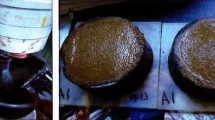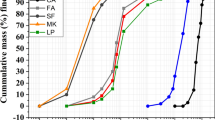Abstract
The aim of this study is to achieve a synergy with positive properties of zeolites such as thermal performance and pozzolanic admixture. For this aim, in the study, analcime and clinoptilolite, the two different natural zeolite minerals, were used as pozzolanic replacement material for blended cements. The replacement ratios with Portland cement of zeolites were 0, 10, 30 and 50%. The clinoptilolite which is widely used in the market was used in comparison with zeolite for the determination of similar properties for analcime. Mortars/concretes containing analcime and clinoptilolite blended cements were produced. In the study, (1) physical, chemical, mechanical, mineralogical, petrographic, thermal properties and pozzolanic activities for analcime and clinoptilolite, (2) conformity tests of blended cements, and (3) strength and the thermal performance for mortars/concretes containing blended cements were determined. The test results have been compared among themselves and with each other. According to the test results, without compromising in terms of strengths of mortars/concretes due to pozzolanic activity, it has been determined that thermal performance of the mortars/concretes containing analcime and clinoptilolite blended cements could be improved. Also, it has been concluded that the analcime has showed similar properties to clinoptilolite in terms of its thermal performance and strength. In some cases, due to these similar properties, analcime may be an alternative pozzolanic additive to clinoptilolite which is commonly used.









Similar content being viewed by others
References
Abergel T, Dean B, Dulac J, Hamilton I. 2018 Global Status Report, Towards a zero-emission, efficient and resilient buildings and construction sector. IEA, Paris, France; 2018. [online] Available at: https://www.iea.org/reports/2018-global-status-report
Ndiaye K, Ginestet S, Cyr M. Thermal energy storage based on cementitious materials: a review. AIMS Energy. 2018;6(1):97–120.
Leong KC, Liu Y. Numerical modeling of combined heat and mass transfer in the adsorbent bed of a zeolite/water cooling system. Appl Therm Eng. 2004;24(16):2359–74. https://doi.org/10.1016/j.applthermaleng.2004.02.014.
Hongois S, Kuznik F, Stevens P. Development and characterization of a new MgSO4—zeolite composite for long-term thermal energy storage. Sol Energy Mater Sol Cells. 2011;95(7):1831–7. https://doi.org/10.1016/j.solmat.2011.01.050.
Duquesne M, Toutain J, Sempey A, Ginestet S, Palomo del Barrio E. Modeling of a nonlinear thermochemical energy storage by adsorption on zeolites. Appl Therm Eng. 2014;71(1):469–80. https://doi.org/10.1016/j.applthermaleng.2014.07.002.
Blanco Varela MT, Martinez Ramirez S, Erena I, Gener M, Carmona P. Characterization and pozzolanicity of zeolitic rocks from two Cuban deposits. Appl Clay Sci. 2006;33(2):149–59. https://doi.org/10.1016/j.clay.2006.04.006.
Chan SYN, Ji X. Comparative study of the initial surface absorption and chloride diffusion of high-performance zeolite, silica fume and PFA concretes. Cement Concr Compos. 1999;21(4):293–300. https://doi.org/10.1016/S0958-9465(99)00010-4.
Ortega EA, Cheeseman C, Knight J, Loizidou M. Properties of alkali-activated clinoptilolite. Cem Concr Res. 2000;30(10):1641–6. https://doi.org/10.1016/S0008-8846(00)00331-8.
Gervais C, Ouki SK. Performance study of cementitious systems containing zeolite and silica fume: effects of four metal nitrates on the setting time, strength and leaching characteristics. J Hazard Mater. 2002;93(2):187–200. https://doi.org/10.1016/S0304-3894(02)00005-5.
Mertens G, Snellings R, Van Balen K, Bicer-Simsir B, Verlooy P, Elsen J. Pozzolanic reactions of common natural zeolites with lime and parameters affecting their reactivity. Cem Concr Res. 2009;39(3):233–40. https://doi.org/10.1016/j.cemconres.2008.11.008.
Najimi M, Sobhani J, Ahmadi B, Shekarchi M. An experimental study on durability properties of concrete containing zeolite as a highly reactive natural pozzolan. Constr Build Mater. 2012;35:1023–33. https://doi.org/10.1016/j.conbuildmat.2012.04.038.
Worrell E, Martin N, Price L. Potentials for energy efficiency improvement in the US cement industry. Energy. 2000;25(12):1189–214. https://doi.org/10.1016/S0360-5442(00)00042-6.
Hasanbeigi A, Price L, Lin E. Emerging energy–efficiency and CO2 emission–reduction technologies for cement and concrete production: a technical review. Renew Sustain Energy Rev. 2012;16(8):6220–38. https://doi.org/10.1016/j.rser.2012.07.019.
Uzal B, Turanlı L. Blended cements containing high volume of natural zeolites: Properties, hydration and paste microstructure. Cement Concr Compos. 2012;34(1):101–9. https://doi.org/10.1016/j.cemconcomp.2011.08.009.
Ahmadi B, Shekarchi M. Use of natural zeolite as a supplementary cementitious material. Cement Concr Compos. 2010;32(2):134–41. https://doi.org/10.1016/j.cemconcomp.2009.10.006.
Perraki T, Kontori E, Tsivilis S, Kakali G. The effect of zeolite on the properties and hydration of blended cements. Cement Concrete Compos. 2010;32(2):128–33. https://doi.org/10.1016/j.cemconcomp.2009.10.004.
Senhadji Y, Escadeillas G, Khelafi H, Mouli M, Benosman AS. Evaluation of natural pozzolan for use as supplementary cementitious material. Eur J Environ Civ Eng. 2012;16(1):77–96. https://doi.org/10.1080/19648189.2012.667692.
Bilim C. Properties of cement mortars containing clinoptilolite as a supplementary cementitious material. Constr Build Mater. 2011;25(8):3175–80. https://doi.org/10.1016/j.conbuildmat.2011.02.006.
Özen S, Göncüoğlu MC, Liguori B, de Gennaro B, Cappelletti P, Gatta GD, Iucolano F, Collella C. A comprehensive evaluation of sedimentary zeolites from Turkey as pozzolanic addition of cement- and lime-based binders. Constr Build Mater. 2016;105:46–61. https://doi.org/10.1016/j.conbuildmat.2015.12.055.
Nizami AS, Ouda OKM, Rehan M, El-Maghraby AMO, Gardy J, Hassanpour A, Kumar S, Ismail IMI. The potential of Saudi Arabian natural zeolites in energy recovery technologies. Energy. 2016;108:162–71. https://doi.org/10.1016/j.energy.2015.07.030.
Zhou B, Shi J, Chen Z. Experimental study on moisture migration process of zeolite-based composite humidity control material. Appl Therm Eng. 2018;128:604–13. https://doi.org/10.1016/j.applthermaleng.2017.08.138.
Özrahat E, Ünalan S. Thermal performance of a concrete column as a sensible thermal energy storage medium and a heater. Renew Energy. 2017;111:561–79. https://doi.org/10.1016/j.renene.2017.04.046.
Hoivik N, Greiner C, Barragan J, Iniesta AC, Skeie G, Bergan P, Blanco-Rodriguez P, Calvet N. Long-term performance results of concrete-based modular thermal energy storage system. J Energy Storage. 2019;24: 100735. https://doi.org/10.1016/j.est.2019.04.009.
Başyiğit C. The effect of zeolite rate on the thermo-mechanical properties of concrete. Int J Phys Sci. 2010;5(7):968–71. https://doi.org/10.5897/IJPS.9000565.
Karakurt C, Topçu IB. Effect of blended cements produced with natural zeolite and industrial by-products on alkali-silica reaction and sulfate resistance of concrete. Constr Build Mater. 2011;25(4):1789–95. https://doi.org/10.1016/j.conbuildmat.2010.11.087.
Albayrak M, Yörükoğlu A, Karahan S, Atlıhan S, Aruntaş HY, Girgin I. Influence of zeolite additive on properties of autoclaved aerated concrete. Build Environ. 2007;42(9):3161–5. https://doi.org/10.1016/j.buildenv.2006.08.003.
Vejmelková E, Koňáková D, Kulovana T, Keppert M, Žumár J, Rovnaníková P, Keršner Z, Sedlmajer M, Černý R. Engineering properties of concrete containing natural zeolite as supplementary cementitious material: Strength, toughness, durability, and hygrothermal performance. Cement Concrete Compos. 2015;55:259–67. https://doi.org/10.1016/j.cemconcomp.2014.09.013.
Jänchen J, Herzog TH, Thrun E. Natural zeolites in thermal adsorption storage and building materials for solar energy utilization in houses. In: Proceedings of insert conference abbreviation, SASEC2015, third Southern African Solar Energy Conference, Kruger National Park, South Africa. 2015; pp. 336–340. http://hdl.handle.net/2263/49532
Akgün Y. A comparative study: blended cements containing analcime and clinoptilolite . Süleyman Demirel Univ J Nat Appl Sci. 2019;23(3):748–58.
CEN EN 197–1 Cement Part 1: Composition, specification and conformity criteria for common cements. European Committee for Standardization. Brussels, Belgium; 2012.
CEN EN 196–1 Methods of testing cement—Part 1: Determination of strength. European Committee for Standardization. Brussels, Belgium; 2016.
TSE TS 25 Natural pozzolan (Trass) for use in cement and concrete—Definitions, requirements and conformity criteria. Turkish Standard Institute. Ankara, Turkey; 2011.
CEN EN 934–2 Admixtures for concrete, mortar and grout—Part 2: Concrete admixtures; Definitions, requirements, conformity, marking and labelling. European Committee for Standardization. Brussels, Belgium; 2013.
CEN EN 196–6 Methods of testing cement—Part 6: Determination of fineness. European Committee for Standardization. Brussels, Belgium; 2010.
ASTM C 311 Test methods for sampling and testing fly ash or natural pozzolans for use as a mineral admixture in portland cement concrete. American Society for Testing and Materials; 2005.
CEN EN 196–3 Methods of testing cement—Part 3: Determination of setting times and soundness, European Committee for Standardization. Brussels, Belgium; 2017.
CEN EN 12390–2 Testing hardened concrete—Part 2: Making and curing specimens for strength tests. European Committee for Standardization. Brussels, Belgium; 2010.
ACI ACI 211.1–91 Standard Practice for Selecting Proportions for Normal, Heavyweight, and Mass Concrete. American Concrete Institute. Farmington Hills, MI, USA; 2009.
CEN EN ISO 8990 Thermal insulation—Determination of steady-State thermal transmission properties-Calibrated and guarded hot box. European Committee for Standardization. Brussels, Belgium; 1989.
CEN EN ISO 6946 Building components and building elements—Thermal resistance and thermal transmittance—Calculation methods. European Committee for Standardization. Brussels, Belgium; 2017.
DIN DIN 51046 Testing of ceramic materials; Determination of thermal conductivity up to 1600 °C according to the hot wire method, thermal conductivity up to 2 WK −1m−1. The German Institute for Standardization. Berlin, Germany; 1976.
CEN EN 993–15, Methods of test for dense shaped refractory products—Determination of thermal conductivity by the hot-wire (parallel) method. European Committee for Standardization. Brussels, Belgium; 2006.
Devecioğlu AG, Biçer Y. Investigation of thermal properties of the expanded clay aggregate concrete. Dicle Univ J Eng Fac. 2012;3(2):75–81.
Incropera FP, De Witt DP, Bergman TL, Lavine AS. Fundamentals of heat and mass transfer. 6th ed. New Jersey: Wiley; 2007.
CEN EN 12620 Aggregates for concrete. European Committee for Standardization. Brussels, Belgium; 2009.
Snellings R, Machiels L, Mertens G, Elsen J. Rietveld Refinement strategy for quantitative phase analysis of partially amorphous zeolitized tuffaceous rocks. Geol Belg. 2010;133:183–96.
Güngör D, Özen S. Development and characterization of clinoptilolite-, mordenite-, and analcime-based geopolymers: a comparative study. Case Stud Constr Mater. 2021;15:e00576. https://doi.org/10.1016/j.cscm.2021.e00576.
Sakızcı M. Investigation of thermal and structural properties of natural and Ion-exchanged analcime. Anadolu Univ J Sci Technol A Appl Sci Eng. 2016;17(4):724–34.
Inglezakis VJ, Zorpas AA. Handbook of natural zeolites. Sharjah: Bentham Science Publishers; 2012. https://doi.org/10.2174/97816080526151120101.
Küçükyıldırım E, Uzal B. Characteristics of calcined natural zeolites for use in high- performance pozzolan blended cements. Constr Build Mater. 2014;73:229–34. https://doi.org/10.1016/j.conbuildmat.2014.09.081.
Oz A, Turkmen I. Relationship between destructive and non-destructive method of concretes containing natural zeolite and blast furnace slag. Sci Res Essays. 2010;5(18):2742–51.
Ozaydin S, Kocer G, Hepbasli A. Natural zeolites in energy applications. Energy Sources Part A Recov Utili Environ Effects. 2006;28:1425–31. https://doi.org/10.1080/15567240500400804.
Dakhli Z, Chaffar K, Lafhaj Z. The effect of phase change materials on the physical, thermal and mechanical properties of cement. Sci. 2019;1(1):27. https://doi.org/10.3390/sci1010027.
Célestin JH, Fall M. Thermal conductivity of cemented paste backfill material and factors affecting it. Int J Min Reclam Environ. 2009;23(4):274–90. https://doi.org/10.1080/17480930902731943.
Duan P, Song L, Yan C, Ren D, Li Z. Novel thermal insulating and lightweight composites from metakaolin geopolymer and polystyrene particles. Ceram Int. 2017;43(6):5115–20. https://doi.org/10.1016/j.ceramint.2017.01.025.
Bentz DP, Peltz MA, Duran-Herrera A, Valdez P, Juarez CA. Thermal properties of high-volume fly ash mortars and concretes. J Build Phys. 2011;34(3):263–75. https://doi.org/10.1177/1744259110376613.
Acknowledgements
This study was funded by the Scientific Research Project Unit of Ordu University under Project No: BY-1736. The author would like to thanks to Laboratories of Dicle University, Laboratories of General Directorate of Mineral Research and Explorations and Gördes Zeolite, Votorantim Cement, Altaş Ready-Mixed Concrete companies.
Author information
Authors and Affiliations
Corresponding author
Additional information
Publisher's Note
Springer Nature remains neutral with regard to jurisdictional claims in published maps and institutional affiliations.
Rights and permissions
About this article
Cite this article
Akgün, Y., Yılmaz, T. Thermal performance of mortars/concretes containing analcime. J Therm Anal Calorim 146, 47–60 (2021). https://doi.org/10.1007/s10973-021-11012-w
Received:
Accepted:
Published:
Issue Date:
DOI: https://doi.org/10.1007/s10973-021-11012-w




